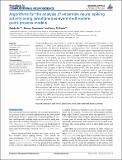Algorithms for the analysis of ensemble neural spiking activity using simultaneous-event multivariate point-process models
Author(s)
Ba, Demba; Temereanca, Simona; Brown, Emery N.
DownloadBrown_Algorithms for.pdf (1.877Mb)
PUBLISHER_CC
Publisher with Creative Commons License
Creative Commons Attribution
Terms of use
Metadata
Show full item recordAbstract
Understanding how ensembles of neurons represent and transmit information in the patterns of their joint spiking activity is a fundamental question in computational neuroscience. At present, analyses of spiking activity from neuronal ensembles are limited because multivariate point process (MPP) models cannot represent simultaneous occurrences of spike events at an arbitrarily small time resolution. Solo recently reported a simultaneous-event multivariate point process (SEMPP) model to correct this key limitation. In this paper, we show how Solo's discrete-time formulation of the SEMPP model can be efficiently fit to ensemble neural spiking activity using a multinomial generalized linear model (mGLM). Unlike existing approximate procedures for fitting the discrete-time SEMPP model, the mGLM is an exact algorithm. The MPP time-rescaling theorem can be used to assess model goodness-of-fit. We also derive a new marked point-process (MkPP) representation of the SEMPP model that leads to new thinning and time-rescaling algorithms for simulating an SEMPP stochastic process. These algorithms are much simpler than multivariate extensions of algorithms for simulating a univariate point process, and could not be arrived at without the MkPP representation. We illustrate the versatility of the SEMPP model by analyzing neural spiking activity from pairs of simultaneously-recorded rat thalamic neurons stimulated by periodic whisker deflections, and by simulating SEMPP data. In the data analysis example, the SEMPP model demonstrates that whisker motion significantly modulates simultaneous spiking activity at the 1 ms time scale and that the stimulus effect is more than one order of magnitude greater for simultaneous activity compared with non-simultaneous activity. Together, the mGLM, the MPP time-rescaling theorem and the MkPP representation of the SEMPP model offer a theoretically sound, practical tool for measuring joint spiking propensity in a neuronal ensemble.
Date issued
2014-02Department
Institute for Medical Engineering and Science; Massachusetts Institute of Technology. Department of Brain and Cognitive SciencesJournal
Frontiers in Computational Neuroscience
Publisher
Frontiers Research Foundation
Citation
Ba, Demba, Simona Temereanca, and Emery N. Brown. “Algorithms for the Analysis of Ensemble Neural Spiking Activity Using Simultaneous-Event Multivariate Point-Process Models.” Frontiers in Computational Neuroscience 8 (2014).
Version: Final published version
ISSN
1662-5188